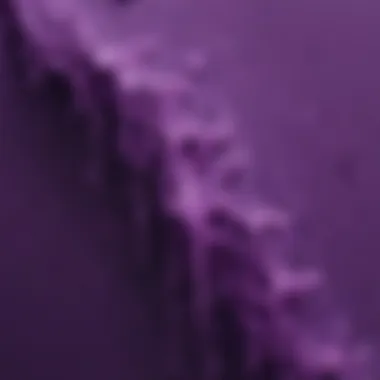Unveiling the Profound Symbolism of Colors in the Holi Festival


The Holi festival is a vibrant celebration steeped in rich symbolism, with each color used carrying profound meanings that add depth to this joyous occasion. From red symbolizing love and fertility to blue embodying the divine, this article delves deep into the significance behind the hues that paint this cultural festivity.
Red: Love and Fertility
Red holds a prominent place in the palette of Holi colors, representing intense emotions like love and fertility. It symbolizes the passion in relationships and the bountiful harvest of the coming season. The color red infuses the festival with warmth and vitality, marking the beginning of a new cycle of growth and prosperity.
Blue: The Divine Essence
In stark contrast to the intensity of red, blue in the Holi festival symbolizes the transcendental and divine. It evokes a sense of spirituality, purity, and serenity, reflecting the presence of the divine amidst the revelry. Blue is a reminder of the sacredness that underlies all creation, inviting participants to connect with the higher realms during the festivities.
Tips and Tricks
As parents and educators navigate the colorful world of Holi, there are several practical tips to enhance children's learning and engagement. Creating art projects centered around the festival's colors can be a fun and educational way to explore its symbolism. Encouraging discussions on the meanings behind each hue can spark curiosity and deeper understanding in young minds.
Practical Tips for Learning
Engaging children in hands-on activities that involve color mixing can help them grasp the concept of symbolism in a tangible way. By incorporating stories related to Holi colors, parents can weave together learning and creativity, fostering a holistic understanding of the festival's cultural significance.
Strategies for Engagement
To make learning about colors and their meanings more interactive, incorporating games that involve matching colors with their associated symbols can be both fun and educational. Encouraging children to express their thoughts and emotions through art can further deepen their connection to the vibrant world of Holi colors.
Synthesis
Understanding the symbolism of colors in the Holi festival unveils a tapestry of meanings that enrich the festive experience. From the vibrant red symbolizing love and fertility to the tranquil blue embodying the divine, each hue adds depth to the cultural celebration. By exploring the profound significance behind the colors of Holi, participants can embrace a deeper connection to tradition, symbolism, and spirituality.


Introduction
The Holi festival, known for its vibrant and lively celebrations, holds a significant place in Indian culture and traditions. Originating from ancient Hindu rituals, Holi is a festival that symbolizes the triumph of good over evil, the arrival of spring, and the celebration of love and colors. In this article, we delve deep into the symbolic importance of the colors present in Holi festivities, uncovering the intricate meanings behind each hue. By understanding the significance of colors in Holi, we can appreciate the depth and richness of this colorful celebration.
As we embark on this exploration of color symbolism in Holi, we aim to shed light on the profound meanings attached to each color, offering readers a closer look at the cultural and spiritual significance of this festival. By unraveling the symbolism behind red, blue, yellow, green, purple, pink, and orange colors used in Holi, we will gain a deeper understanding of the traditions and beliefs that shape this vibrant occasion. Through this comprehensive guide, we seek to provide readers with an immersive experience, allowing them to connect with the essence of Holi on a deeper level while exploring the customs and practices associated with this joyous festival.
History of Holi Festival
The history of the Holi Festival holds immense significance in unraveling the cultural tapestry of this vibrant celebration. Delving into the roots of this festival sheds light on the traditions, rituals, and beliefs that have been passed down through generations. Understanding the historical context of the Holi Festival allows us to appreciate the evolution and relevance of its customs in contemporary times. Exploring the origins of this festival provides a nuanced perspective on how it has shaped community bonds and cultural practices over the centuries.
Ancient Origins of Holi
The ancient origins of the Holi Festival trace back to Hindu mythology, specifically the legend of Radha and Krishna. It is believed that the playful ritual of applying colors originated from Krishna's fondness for smearing colors on Radha and her companions. This act symbolizes the expression of love, unity, and the triumph of good over evil. Furthermore, Holi can be linked to various folklore and agricultural traditions, marking the onset of spring and the season of harvest. These ancient roots underscore the deep spiritual and symbolic significance attached to the colorful festivities.
Evolution of Holi Celebrations
Over time, the celebrations of Holi have evolved from simple color play to elaborate festivities encompassing music, dance, and communal gatherings. The evolution of Holi reflects the dynamic nature of cultural practices, where traditional customs blend with contemporary interpretations. Modern Holi celebrations include a diverse range of activities, such as bonfires, water balloon fights, and cultural performances, incorporating elements from different regions and communities. This evolution highlights the adaptability and inclusivity of the festival, making it a truly universal and joyous occasion.
Significance of Colors in Holi
The significance of colors in the Holi festival is deeply rooted in the cultural and spiritual traditions of India. Each color used during this festive occasion holds a specific symbolism that reflects a variety of emotions and meanings. Understanding the significance of colors in Holi adds a layer of depth to the festivities, enriching the overall experience for participants and observers alike.
Red Color
In Holi, the color red symbolizes love and fertility, invoking feelings of passion and vitality. It represents the eternal bond of love and the cycle of life, making it a key hue in the celebrations. The vibrant red powder thrown during Holi not only brightens the surroundings but also evokes a sense of desire and energy. Red's association with fertility underscores the renewal and regenerative aspects of the festival, ushering in new beginnings and growth.


Blue Color
Blue is revered in Holi for its representation of the divine. The color exudes a sense of spirituality, invoking feelings of calmness and serenity amidst the vibrant chaos of the festivities. Blue symbolizes transcendence and higher consciousness, reminding participants of the sacred origins of the celebration. By incorporating blue into the color palette of Holi, individuals pay homage to the divine forces that guide and protect them.
Yellow Color
The color yellow in Holi signifies luminosity and prosperity, radiating warmth and positivity. Yellow represents enlightenment and intellect, illuminating the path towards success and abundance. Embracing the color yellow during Holi fosters a sense of joy and optimism, encouraging individuals to embrace their inner light and aspirations. The golden hues of yellow reflect the brightness of the sun, symbolizing vitality and growth.
Green Color
Green holds a special place in Holi as it is connected to nature and harmony. The color green represents balance and renewal, echoing the arrival of spring and blooming life. Green symbolizes fertility and rejuvenation, signaling the end of winter's stagnation and the beginning of a new season. By incorporating green into the festivities, participants express their reverence for the natural world and the cyclical rhythms of existence.
Purple Color
In Holi, purple is associated with power and luxury, exuding a sense of regality and opulence. The color purple signifies authority and ambition, embodying a sense of grandeur and sophistication. By including purple in the festivities, individuals acknowledge their aspirations for success and prestige. Purple's deep hues add a touch of extravagance to the celebration, elevating the atmosphere with its rich connotations.
Pink Color
Pink in Holi represents playfulness and affection, infusing the festivities with a sense of joy and camaraderie. The color pink symbolizes love, friendship, and compassion, fostering connections between individuals. Pink's light-hearted essence adds a touch of whimsy to the celebrations, encouraging participants to embrace their playful side. Embracing pink during Holi evokes feelings of warmth and togetherness, enhancing the overall atmosphere of conviviality and merriment.
Orange Color
Orange embodies energy and enthusiasm in Holi, reflecting a zest for life and vibrant spirit. The color orange symbolizes creativity and vitality, inspiring individuals to embrace new beginnings and opportunities. By incorporating orange into the color palette of Holi, participants infuse the celebrations with a sense of zeal and dynamism. Orange's vibrant tones uplift the mood and fuel a sense of excitement, igniting the festive spirit with its lively hues.
Cultural and Social Implications


In the context of the Holi festival, the Cultural and Social Implications bear significant weight, reflecting deep-rooted beliefs and fostering communal bonds. This section delves into the intrinsic connection between the festival's vibrant colors and its impact on the socio-cultural fabric. Understanding the essence of Cultural and Social Implications enriches our comprehension of Holi beyond its visual spectacle.
Unity and Brotherhood
Unity and Brotherhood stand as pillars of the Holi festival, embodying the spirit of togetherness and harmony. This subsection explores how the hues of Holi transcend mere colors, acting as conduits for consolidating relationships and fostering unity among diverse communities. By immersing in the sea of colors collectively, individuals partake in a shared experience that transcends boundaries and differences, reinforcing the values of empathy and solidarity.
Breaking Barriers
In the spirit of Breaking Barriers, Holi emerges as a symbol of inclusivity and openness, dissolving societal divides and prejudices. This segment delves into how the festival dismantles conventional barriers, encouraging interactions devoid of distinctions. Through the kaleidoscope of colors, Holi encourages individuals to embrace diversity, challenge stereotypes, and promote acceptance, thus paving the way for a more inclusive society where differences are celebrated rather than scrutinized.
Modern Interpretations
In this section of the article, we shed light on the critical aspect of 'Modern Interpretations' within the context of the Holi festival. Understanding the contemporary relevance of this ancient tradition is paramount to appreciating how it has evolved and influenced various aspects of society. Modern Interpretations serve as a bridge between tradition and innovation, shaping how individuals perceive and engage with cultural practices. By exploring how Holi's symbolism has adapted to modern sensibilities, we gain insights into the dynamic nature of cultural celebrations and their enduring impact.
Influence on Fashion and Design
The intertwining of Holi's symbolic colors with the realm of fashion and design has had a profound effect on aesthetic trends and creative expressions. Designers draw inspiration from the vibrant hues of Holi to craft clothing lines and artistic pieces that reflect the festival's exuberance and cultural significance. The playful juxtaposition of colors represents a departure from conventional palettes, infusing new energy and excitement into the fashion industry. Through innovative design choices, the influence of Holi on fashion extends beyond mere aesthetics, encouraging individuals to embrace bold and unconventional styles that celebrate diversity and individuality.
Commercialization and Global Appeal
The commercialization of the Holi festival has led to its widespread recognition on a global scale, transforming it from a traditional event into a universal phenomenon. As businesses capitalize on the vibrant symbolism of Holi's colors, merchandise featuring popular hues saturates the market during the festive season. The accessibility of Holi-themed products caters to a broad audience, sparking interest in the festival's cultural origins and traditions across different communities worldwide. While commercialization has facilitated the global appeal of Holi, it also prompts discussions about cultural appropriation and the preservation of authenticity in a commercialized landscape. Balancing the commercial aspects of Holi with its cultural integrity remains a key challenge in sustaining the festival's essence amidst evolving consumer preferences.
Conclusion
In this article dissecting the symbolism of colors in the Holi festival, it becomes evident that the significance of colors goes beyond mere aesthetics, delving deeply into cultural and spiritual realms. The culminating section, the Conclusion, holds a pivotal role in synthesizing the multifaceted meanings embodied by each color. It serves as the unifying element that encapsulates the essence of the festival's chromatic symbolism.
The Conclusion elucidates the interconnectedness between colors and emotions, portraying how each shade transcends visual appeal to communicate profound narratives. By reflecting on the diverse connotations attached to red, blue, yellow, green, purple, pink, and orange, we unravel a tapestry of meanings that intertwine with human experiences and beliefs.
Moreover, the Conclusion furnishes a reflection on the transformative power of colors, highlighting how their symbolism permeates various aspects of life beyond the Holi festival. It invites readers to contemplate the universal language of colors, connecting diverse cultures and traditions through a shared visual vocabulary.
Furthermore, the Conclusion reinforces the importance of honoring cultural heritage and embracing diversity through the celebration of festivals like Holi. It accentuates the role of colors as vehicles of expression, uniting communities in joyous revelry while fostering inclusivity and understanding.
In essence, the Conclusion acts as a beacon of insight, guiding readers towards a deeper appreciation of the cultural significance and symbolism of colors in the Holi festival. Through its synthesis of information and reflection on the profound meanings ingrained in each hue, the Conclusion leaves a lasting impact, resonating with readers long after they have immersed themselves in the vibrant world of Holi colors.















